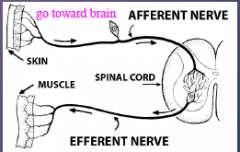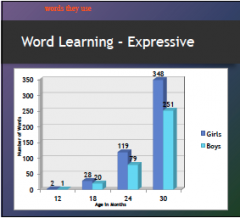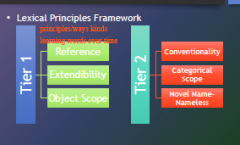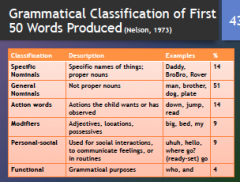![]()
![]()
![]()
Use LEFT and RIGHT arrow keys to navigate between flashcards;
Use UP and DOWN arrow keys to flip the card;
H to show hint;
A reads text to speech;
165 Cards in this Set
- Front
- Back
|
How are language and cognition related? |
Intertwined - don't have one without the other |
|
|
What is meant by "modularity"? |
Separate areas do specialized function (some overlap)
organization of mind |
|
|
CNS vs PNS |
CNS: brain & spinal cord, protective layers (bone & membrane)
PNS: cranial nerves (12), Spinal Nerves (31), afferent & efferent pathways
Cranial Nerves Imp. for Speech - Trigeminal (V) - Facial (VII) - Vestibulocochlear (VIII) - Glossopharyngeal (IX) - Vagus (X) - Accessory (XI) - Hypoglossal (XII) |
|
|
Brain location terminology
(Horizontal, rostral, distal, afferent, efferent) |

|
|
|
Different Lobes of the brain |
Frontal Parietal Temporal Occipital
|
|
|
Frontal |
executive functions, gross/fine motor planning, coordination of speech
contralateral organization
|
|
|
Parietal |
perception & integration of sensory info., comprehension of oral & written language, primary sensory cortex |
|
|
Temporal |
processing auditory info. & lang. comprehension,
Heschls' gyrus (connects Broca's & Wernicke's),
Wernicke's area |
|
|
Occipital |
Vision |
|
|
How do scientists learn how the brain processes language? |
PET scans, MRI, fMRI, other scans |
|
|
Where in the brain is language processed? |
Broca's, Wernicke's, specific language module |
|
|
Sensitive Period |
neuroanatomical or physiological aspect supporting sensory/motor capacity grows & changes |
|
|
Synaptogenesis |
formation of synaptic connections
(most rapidly during 1st yr., after there is pruning) |
|
|
Synaptic Pruning |
excess synapses are pruned after synaptogenesis
(end of 1st yr. to adolescence) |
|
|
Neural Plasticity |
malleability of the CNS or ability of the sensory & motor systems to organize & reorganize by generating new synaptic connections or by using existing synapses for alternative means |
|
|
Experience-expectant (Neural Plasticity) |
changes that occur as a result of normal experiences |
|
|
Experience-dependent (Neural Plasticity) |
changes that occur as a result of unique experiences |
|
|
Linguistic |
use of conventional words, signs or symbols to communicate |
|
|
Prelinguistic |
use of coordinated eye gaze combined with gestures &/or vocalizations to communicate |
|
|
Perlocutionary |
0-8 months;
Child's action & behaviors are given communicative intent by caregivers |
|
|
Illocutionary |
8-12 months;
Child produces first truly intentional behavior either vocally or gesturally |
|
|
Locutionary |
12+ months;
Child combines words & gestures to communicate, using words (linguistic side) |
|
|
Age at which intentional prelinguistic communication emerges |
9-10 months |
|
|
When do infants typically comprehend first words? Produce first words? |
12 months |
|
|
Protoimperatives
(Protoimperatives vs Protodeclaratives) |
communicative acts intended to direct another person to carry out an action
(requests; wanting cookie, point at it to request) |
|
|
Protodeclaratives (Protoimperatives vs Protodeclaratives) |
communicative acts that are social in nature & direct another person's attention to an object, entity or event of interest
(comments; look plane, just want person to acknowledge they see it too) |
|
|
Behavior Regulation
(Behavior Regulation vs Social Interaction vs Joint Attention) |
(same as proto-imperatives)
used to regulate the behavior of another person to obtain a specific result
(ex: demand object, refuse object, command someone to do something, refuse activity by someone)
- most are to request an action at any stage of acquisition |
|
|
Social Interaction
(Behavior Regulation vs Social Interaction vs Joint Attention) |
(broad idea of proto-declaratives)
acts used to attract or maintain another's attention to oneself
(ex: get attentions, show off, greeting, calling, request social routine)
- most are requesting social routine (peek-a-boo, pat-a-cake) |
|
|
Joint Attention
(Behavior Regulation vs Social Interaction vs Joint Attention) |
act used to direct another's attention to an object, event or topic of a communicative act
(ex: transferring-give object, comment on object, comment on action/event, request info, clarification)
- most is comment |
|
|
Developmental stages of Coordinated Joint Attention |
<5mon(attention to soc. partners)
5-6mon(supported JA)
6-13mon(consolidation of JA)
18+mon(symbol infused coordinated attention) |
|
|
Coordinated Joint Attention |
child's attention flows between people, objects & symbols within a communicative exchange |
|
|
Deictic Gestures
(Deictic Gestures vs Play Schemes vs Representational Gestures) |
point at some place |
|
|
Play Schemes
(Deictic Gestures vs Play Schemes vs Representational Gestures)
|
actions carried out on an object & depict the object in terms of function
(use object for what it is supposed to be used for) |
|
|
Representational Gestures
(Deictic Gestures vs Play Schemes vs Representational Gestures) |
carry-out meaning in own form to symbolize a referent
(pretend to have an object & use it) |
|
|
Why are gestures important? |
prognostic indicator of expressive language;
gesture teaching may facilitate lang. dev.;
symbolic gestures acquired earlier than spoken words (facilitate expressive gestures) |
|
|
QRN Forms |
non-crying sounds,
not fully resonated sounds,
not adult sounds |
|
|
Babbling |
random, single CV syllable, experimenting with sounds |
|
|
Reduplicated Babbling |
repeat same syllable |
|
|
Variegated Babbling |
change consonants & vowels |
|
|
Phonetically Consistent |
similar to referent, banana=wawa |
|
|
Know sequence of development of vocalizations |
0-2mon: Reflexive(crying)
1-4mon: control of phonation(cooing&gooing);
3-8mon: expansion(true vowels, squealing);
5mon: babbing(single syll. CV);
8mon: reduplicated; 10mon: variegated;
9-18mon: jargon, phonetically consistent |
|
|
Noncanonical
(Noncanonical vs Canonical vs Multisyllables) |
production of only vowel-like sounds OR only consonants or glides
(ex: [i],[m:],[ha]) |
|
|
Canonical
(Noncanonical vs Canonical vs Multisyllables) |
production of a syllable composed of both true consonant & vowel
(ex: [da], [fa], [am] |
|
|
Multisyllables
(Noncanonical vs Canonical vs Multisyllables) |
more than 1 syllable in communicative act
(ex: uhoh, [o i]) |
|
|
Why are vocalizations important? |
- children tend to use same phonemes in their early words that they frequently used in babbling - across langs., freq. of phonemes used in babbling maps to the relative freq. they are used in early words - preling. children w/expressive lang. impairment have reduced consonantal inventories & reduced freq. of canonical vocalizations |
|
|
Definition of word |
1. word must occur in presence of referent or appropriate context
2. child's utterance has a phonetic relationship to adult word
3. child must use the word consistently |
|
|
Early milestones related to word learning |

|
|
|
Factors influencing word learning differences |
socioeconomic status - impacts # of words child gets as input;
education of parents - types & amount of words input |
|
|
What, when, why of vocabulary spurt |
What: 50-100 words acquired;
Why: dev. of control over articulatory system, knowledge of role of synatactic patterns, underlying growth in cognitive capacities;
When:around 16-18 months |
|
|
Late Bloomer
("Late Bloomer" vs "Language Impaired") |
behind, eventually catch up |
|
|
Language Impaired
("Late Bloomer" vs "Language Impaired") |
lifelong language problems |
|
|
Fast Mapping
(Fast vs Slow Mapping) |
visual, auditory characteristics/features of object |
|
|
Slow Mapping
(Fast vs Slow Mapping) |
more advanced knowledge of object, beyond senses |
|
|
Under-extensions
(Under- vs Over-extensions) |
expressive & receptive
(early words - ex: dog only means their dog); |
|
|
Over-extensions
(Under- vs. Over-extensions |
categorical overinclusions, analogical overextensions, predicate statements |
|
|
Categorical Overinclusions
(Over-extensions) |
extending word based on category membership (anything 4 legs = dog) |
|
|
Analogical Over-extensions
(Over-extensions) |
extending word use based on perceptual, functional or affective similarity
(things associated with different item become dog too - anything with fur) |
|
|
Predicate Statement
(Over-extensions) |
extending word use based on relationship between object & some absent person, object, property or state (associated with object is the name of object) |
|
|
Reference
(Lexical Principles) |
words label objects, actions & events
(1st association will be to link a word to an object) |
|
|
Extendibility
(Lexical Principles) |
child assumes shared perceptual attributes
(for all items in class) (shape bias) |
|
|
Object Scope
(Lexical Principles) |
label refers to whole entity |
|
|
Conventionality
(Lexical Principles) |
right way to say words
(shift to 'real' conventional word); |
|
|
Categorical Scope
(Lexical Principles) |
rely more on category than theme or perceptual similarities; |
|
|
Novel Name-Nameless
(Lexical Principles) |
novel word must go with unnamed referent
(mutual exclusivity: each referent has its own name) |
|
|
Lexical Principles - Tier 1 and 2 |

|
|
|
Factors influencing word learning |
Phonotactic Probability: high better than low; Freq. of encounter; Evocative Utterances: naming statements; Hypothesis Testing Utterances: seek confirmation of word meaning |
|
|
Pragmatic categories of early words; which are most common |
Procedural: calling (ex: mommy)
Representational: content questioning, naming/labeling, statement/declaring, answering (ex: wassat? doggie, eat, horsie)
Expressive: exclaiming, verbal accompaniment to action, expressing state or attitude (ex: yes, uhoh, tired) |
|
|
Reduplication
(Phonological forms of early words) |
Reduplication (CVCV): wawa, mama, beebee(baby) |
|
|
Assimilation
(Phonological forms of early words) |
don't add new/different consonants: gog(dog) caki(candy) |
|
|
CVCV Construction
(Phonological forms of early words) |
howsie(horse) dukie(duck) |
|
|
Open Syllable
(Phonological forms of early words) |
no final consonant & use reduplication - bakie(blanket) baba(bottle) |
|
|
Cluster Reductions
(Phonological forms of early words) |
top(stop) tee(tree) |
|
|
Grammatical Classification of Early Words & explainations |

|
|
|
Existence
(Existence vs Nonexistence vs Disappearance vs Recurrence) |
Relative to the object
Existence: exists (this) |
|
|
Nonexistence
(Existence vs Nonexistence vs Disappearance vs Recurrence) |
Relative to the object
Nonexistence (no) |
|
|
Disappearance
(Existence vs Nonexistence vs Disappearance vs Recurrence) |
Relative to the object
Disappearance (all gone) |
|
|
Recurrence
(Existence vs Nonexistence vs Disappearance vs Recurrence) |
Relative to the object
Recurrence (more) |
|
|
Protoverbs |
objects relate through movement;
in, out, off, up, down, no, on, here, inside, bye-bye |
|
|
Bilingualism |
being fluent in two languages |
|
|
Simultaneous Bilinguialism |
children hear 2 languages from birth, language across numerous contexts |
|
|
Sequential Bilingualism |
children hear 1 language for 1st few years & later are exposed to another language which they acquire |
|
|
Fusion Hypothesis (Theories of Bilingual Dev.) |
children initially create 1 system that combines 2 langs. they hear ->
stages: 1. 1 lexicon w/words from both languages 2. 2 lexicons but apply syntactic rules of 1 language 3. 3 yrs have 2 fully differentiated systems |
|
|
Autonomous Development (Theories of Bilingual Dev.) |
kids differentiate 2 languages they hear & acquire each uninfluenced by other (languages are separate) |
|
|
Interdependent Development (Theories of Bilingual Dev.) |
kids differentiate 2 languages they hear but the course of the development of each is influenced by the other (know difference between 2 but they influence) |
|
|
Current Research (Theories of Bilingual Dev.) |
- key milestones occur in same age range for monolingual & bilingual kids - individual variation in rate & pattern of normal language development - no neurocognitive reason why kids shouldn't be able to acquire multiple languages |
|
|
Experimental (Methods for studying expressive & receptive language) |
researcher actively manipulates variables of interest |
|
|
Observational/Naturalistic (Methods for studying expressive & receptive language) |
examine kid's language use in naturalistic or semi-structured contexts, usually recorded |
|
|
Experimental (Naturalistic vs experimental approaches to examining language) |
elicit language samples through specific tasks |
|
|
Naturalistic (Naturalistic vs experimental approaches to examining language) |
collect language samples in kid's natural environment |
|
|
Purposes of language sample - Research |
- confirm general linguistic principles - discover principles of language development - clarify relationship of language to develop in other areas(cognition) - provide more or less theoretical description of language development |
|
|
Purposes of language sample - Clinically |
- diagnose language impairment - characterize language impairment - develop treatment - monitor treatment progress |
|
|
Example of good language sampling context for children of different ages |
quiet, comfortable place (home, school, clinic) |
|
|
Example of good materials to use when obtaining a language sample |
audio recorder with good microphone, stimulating materials (books, pictures, toys) |
|
|
Interaction strategies for the examiner to use when obtaining a language sample |
Freeplay Narrative (generate/retell fictional story, retell event) Conversation (interview format) Expository Text (describes procedure/give instructions)
|
|
|
C-Unit |
Utterance includes main clause plus subordinating clauses
ex: because, that, when, who, after, before, so, which, although, if, unless, while, as, how, until, as...as, like, where |
|
|
Maze |
repetitions, revisions, false starts & filled pauses marked in parentheses ex: And (the) the boy was said -- repetition And then (the boy) the dog went home -- revision It was a big (um um) bird -- filled pauses (ah, er, eh, um, uh) |
|
|
Nouns |
person, place, things, of abstractions
labels we use to classify the world and our experiences |
|
|
Simple Nouns |
single words |
|
|
Compound nouns |
more than one word that can appear in various forms
(chalkboard is a closed compound, vice president is an open compound) |
|
|
Common Nouns (Noun Classes) |
general group or class of indefinite animal, condition, material, object, person, place, or quality
These are typically not capitalized |
|
|
Proper Nouns (Noun Classes) |
specific entities and always capitalized |
|
|
Concrete Nouns |
tangible, physical entities (pencil, Eiffel Tower) |
|
|
Abstract Nouns |
intangible, nonphysical entities (five senses).
They are often words to describe emotions, senses, etc. (love, fear, reason) |
|
|
Count Nouns |
countable objects (leg, clock, banana) |
|
|
Non-count Nouns |
does not have individual elements (progress, mail, courage, wheat) |
|
|
Collective Nouns |
group acting as a unit (class, audience, staff).
They be singular or plural. |
|
|
Noun Forms |
dimensions that represent its form |
|
|
Number (Noun Forms) |
plural vs. singular |
|
|
Gender (Noun Forms) |
can have masculine characteristics (gentlemen, king), feminine characteristics (ladies, queen), or indefinite (apply to both gender; child, doctor, sibling) |
|
|
Case (Noun Forms) |
can be characterized as: Nominative, Objective & Possessive |
|
|
Nominative (Case) |
nouns are serving as the subject in the sentence |
|
|
Objective (Case) |
the noun is the object in the sentence |
|
|
Possessive (Case) |
denote ownership ('s) |
|
|
After the 2nd year of life, nouns are __% of the vocab and are _____ and serve to name object
Steadily decrease as child ages.. __% by teens |
60; nominals
20 |
|
|
Pronouns |
finite group of words used to replace nouns and allow us to be more efficient in our speech |
|
|
Personal Pronouns |
replace nouns that represent persons or entities |
|
|
Nominative Pronouns (Personal Pronouns) |
used when pronoun serves as the subject (I, you, she, he, it, we, they) |
|
|
Objective Pronouns (Personal Pronouns) |
pronouns that are used when the pronoun serves as the object (me, you, him, her, it, us, them) |
|
|
Possessive Pronouns (Personal Pronouns) |
signifies possession or ownership (mine, yours, his, hers, its, ours, their, theirs) |
|
|
Reflexive Pronouns (Personal Pronouns) |
formed by adding the suffix –self or –selves. They can also be called compound personal pronouns. (himself) |
|
|
Demonstrative Pronouns |
identify or highlight a particular antecedent (this and that are singular and those and these are plural
They are also based on the location of the referent |
|
|
Indefinite Pronouns |
pronouns: general unstated referents or nonexistent groups (nobody, everyone, several)
They can be plural or singular. |
|
|
Relative Pronouns |
1) refer to a noun or a pronoun as do other pronoun types
2) embed or conjoin a portion of a sentence to the rest of the sentence (who, whoever, what, which, that, these) |
|
|
Relative Clause (Relative Pronouns) |
component of a complex sentence that includes its own subject and predicate, but it must be combined with an independent clause |
|
|
Interrogative Pronouns |
used to ask wh- questions (who, what, where, when) and specifically used to ask a question |
|
|
Age 3: Pronouns are __& of vocab & by age 9 they are __% |
20; 17 |
|
|
Stages of pronoun use: |
1. rarely use pronouns to link utterances (2-5)
2. use pronouns to refer to the main character of a story (5-8)
3. use pronouns freely in story telling (8+) |
|
|
Verb |
describe what nouns and pronouns do and what is done to them |
|
|
Main Verbs |
principle descriptor of an action or state of being |
|
|
Auxilliary Verbs |
conjoined with main verbs used to clarify the action or state of being of the main verb |
|
|
BE Verbs |
“copula”.
Can be used as a subject or auxiliary verb.
Can take the form as am, is, are, was, being, were, and been |
|
|
Transitive Verbs |
action or state of a subject that is carried over to the object
(Jonathan KICKED the ball) |
|
|
Intratransitive Verbs |
may stand by themselves without needing and object
(she dreams) |
|
|
Verb forms |
number person tense voice mood |
|
|
Number (Verb Forms) |
can be plural or singular |
|
|
Person (Verb Forms) |
contains info pertaining to who is doing the action
(They ARE working vs She IS working) |
|
|
Tense (Verb Forms) |
time of action |
|
|
Present (Tense) |
right now |
|
|
Past (Tense) |
occurred previously |
|
|
Future (Tense) |
will occur |
|
|
Simple Present (Tense) |
actions that exist now |
|
|
Simple Past (Tense) |
actions that occurred once in a particular time |
|
|
Simple Future (Tense) |
actions that will occur once |
|
|
Progressive (Tense) |
a continuation of an action or state of being (ing)
|
|
|
Present Progressive (Tense) |
combining am, is, or are with present participle
Describes actions that are still happening now (is jumping) |
|
|
Past Progressive (Tense) |
combines was or were with present participle
actions that were in progress in the past (was jumping) |
|
|
Future Progressive (Tense) |
combines will be or shall be with the present progressive (will be jumping)
states of being that will be in progress in the future |
|
|
Perfect Tense (Tense) |
actions or states of being that have happened in the past |
|
|
Present Perfect (Tense) |
combining has or have with past participle
Describes action that had been continuing up until present (has missed) |
|
|
Past Perfect (Tense) |
formed by combining had with past participle and indicate actions or states of the past
(had missed) |
|
|
Future Present (Tense) |
formed by combining will have or shall have and the past participle and they convey actions
or states of being that will be or shall be completed before a particular time in the future
(will already have eaten) |
|
|
Voice |
modified to indicate whether the subject to which it refers is doing the action or receiving the action
|
|
|
Action Voice |
subjects are performing the action (Miguel is eating the apple) |
|
|
Passive Voice |
emphasis of the subjects (apple) is on them as recipients of an action
(the apple is being eaten by Miguel) |
|
|
Mood |
depicts the speaker's state of mind (level of intention) |
|
|
Indicative Mood |
used when one is stating a fact or requesting information
(the dog IS a terrier) |
|
|
Imperative Mood |
give command or make a request
(TELL that terrier to stop barking) |
|
|
Subjunctive Mood |
used in dependent clauses in expressing wishes and demands
(I wish I WERE a little bit taller) |
|
|
Verbals |
derived from verbs, but they function in different ways and include infinitives, gerunds, and participles |
|
|
Infinitive Verbals |
characterized be to plus verb (Jim is calling us TO TELL us about the class) |
|
|
Gerunds (Verbals) |
-ing form of the present participle |
|
|
Participles (Verbals) |
can be the present or past tense of a verb tense
For present add -ing and for past add -ed |
|
|
2 word utterances around __ months |
18 |
|
|
When do verbs first appear |
2 yrs |
|
|
Age 9-10 __% of words are verbs; by adolescence __% are verbs |
25; 30 |

